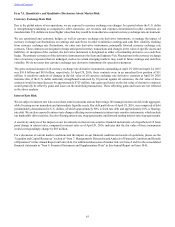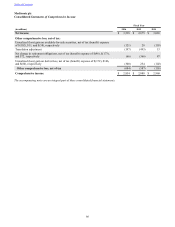Medtronic 2016 Annual Report Download - page 76
Download and view the complete annual report
Please find page 76 of the 2016 Medtronic annual report below. You can navigate through the pages in the report by either clicking on the pages listed below, or by using the keyword search tool below to find specific information within the annual report.
Table of Contents
Medtronic plc
Notes to Consolidated Financial Statements (Continued)
73
expense, net, and are offset by changes in the fair value of the underlying debt instrument. The gains (losses) from terminated
interest rate swap agreements are recorded in long-term debt, increasing (decreasing) the outstanding balances of the debt, and
amortized as a reduction of (addition to) interest expense, net over the remaining life of the related debt. The cash flows from the
termination of the interest rate swap agreements are reported as operating activities in the consolidated statements of cash flows.
In addition, the Company has collateral credit agreements with its primary derivative counterparties. Under these agreements,
either party is required to post eligible collateral when the market value of transactions covered by the agreement exceeds specific
thresholds, thus limiting credit exposure for both parties.
Fair Value Measurements The Company follows the authoritative guidance on fair value measurements and disclosures with
respect to assets and liabilities that are measured at fair value on both a recurring and nonrecurring basis. Under this guidance, fair
value is defined as the exit price, or the amount that would be received to sell an asset or paid to transfer a liability in an orderly
transaction between market participants as of the measurement date. The authoritative guidance also establishes a hierarchy for
inputs used in measuring fair value that maximizes the use of observable inputs and minimizes the use of unobservable inputs by
requiring that the most observable inputs be used when available. Observable inputs are inputs market participants would use in
valuing the asset or liability, based on market data obtained from sources independent of the Company. Unobservable inputs are
inputs that reflect the Company’s assumptions about the factors market participants would use in valuing the asset or liability
developed based upon the best information available in the circumstances. The categorization of financial assets and financial
liabilities within the valuation hierarchy is based upon the lowest level of input that is significant to the fair value measurement.
The hierarchy is broken down into three levels defined as follows:
• Level 1 - Inputs are quoted prices in active markets for identical assets or liabilities.
• Level 2 - Inputs include quoted prices for similar assets or liabilities in active markets, quoted prices for identical
or similar assets or liabilities in markets that are not active, and inputs (other than quoted prices) that are observable
for the asset or liability, either directly or indirectly.
• Level 3 - Inputs are unobservable for the asset or liability.
Financial assets that are classified as Level 1 securities include highly liquid government bonds within U.S. government and agency
securities, marketable equity securities, and exchange-traded funds for which quoted market prices are available. In addition, the
Company classifies currency forward contracts as Level 1 since they are valued using quoted market prices in active markets which
have identical assets or liabilities.
The valuation for most fixed maturity securities are classified as Level 2. Financial assets that are classified as Level 2 include
corporate debt securities, government and agency securities, certificates of deposit, other asset-backed securities, debt funds, and
certain mortgage-backed securities whose value is determined using inputs that are observable in the market or can be derived
principally from, or corroborated by, observable market data such as pricing for similar securities, recently executed transactions,
cash flow models with yield curves, and benchmark securities. In addition, interest rate swaps are included in Level 2 as the
Company uses inputs other than quoted prices that are observable for the asset. The Level 2 derivative instruments are primarily
valued using standard calculations and models that use readily observable market data as their basis.
Financial assets are considered Level 3 when their fair values are determined using pricing models, discounted cash flow
methodologies, or similar techniques, and at least one significant model assumption or input is unobservable. Level 3 financial
assets also include certain investment securities for which there is limited market activity such that the determination of fair value
requires significant judgment or estimation. Level 3 investment securities include certain corporate debt securities, auction rate
securities, and certain mortgage-backed securities. With the exception of auction rate securities, these securities were valued using
third-party pricing sources that incorporate transaction details such as contractual terms, maturity, timing, and amount of expected
future cash flows, as well as assumptions about liquidity and credit valuation adjustments by market participants. The fair value
of auction rate securities is estimated by the Company using a discounted cash flow model, which incorporates significant
unobservable inputs. The significant unobservable inputs used in the fair value measurement of the Company’s auction rate securities
are years to principal recovery and the illiquidity premium that is incorporated into the discount rate. Significant increases
(decreases) in any of those inputs in isolation would result in a significantly lower (higher) fair value of the securities.
Warranty Obligation The Company offers a warranty on various products. The Company estimates the costs that may be incurred
under its warranties and records a liability in the amount of such costs at the time the product is sold. The amount of the reserve
recorded is equal to the net costs to repair or otherwise satisfy the obligation. The Company includes the warranty obligation in
other accrued expenses and other long-term liabilities on the consolidated balance sheets.
























